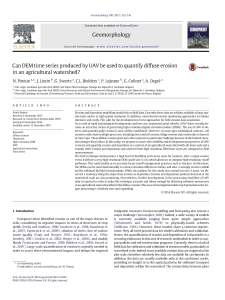Pineux N., Lisein J., Swerts G., Bielders C.L., Lejeune P., Colinet G., Degré A.
Erosion and deposition modelling should rely on field data. Currently these data are seldom available at large spatial scales and/or at high spatial resolution. In addition, conventional erosion monitoring approaches are labour intensive and costly. This calls for the development of new approaches for field erosion data acquisition.
As a result of rapid technological developments and low cost, unmanned aerial vehicles (UAV) have recently become an attractive means of generating high resolution digital elevation models (DEMs). The use of UAV to observe and quantify gully erosion is now widely established. However, in some agro-pedological contexts, soil erosion results from multiple processes, including sheet and rill erosion, tillage erosion and erosion due to harvest of root crops. These diffuse erosion processes often represent a particular challenge because of the limited elevation changes they induce. In this study,we propose to assess the reliability and development perspectives of UAV to locate and quantify erosion and deposition in a context of an agricultural watershed with silt loam soils and a smooth relief. Erosion and deposition rates derived from high resolution DEM time series are compared to field measurements.
The UAV technique demonstrates a high level of flexibility and can be used, for instance, after a major erosive event. It delivers a very high resolution DEM(pixel size: 6 cm) which allows us to compute high resolution runoff pathways. This could enable us to precisely locate runoff management practices such as fascines. Furthermore, the DEMs can be used diachronically to extract elevation differences before and after a strongly erosive rainfall and be validated by field measurements. While the analysis for this study was carried out over 2 years, we observed a tendency along the slope from erosion to deposition. Erosion and deposition patterns detected at the watershed scale are also promising. Nevertheless, further development in the processing workflow of UAV data is required in order to make this technique accurate and robust enough for detecting sediment movements in an agricultural watershed affected by diffuse erosion. This area of investigation holdsmuch potential as the images processing is relatively new and expanding.
Consultez la notice complète de l’article sur ORBi

